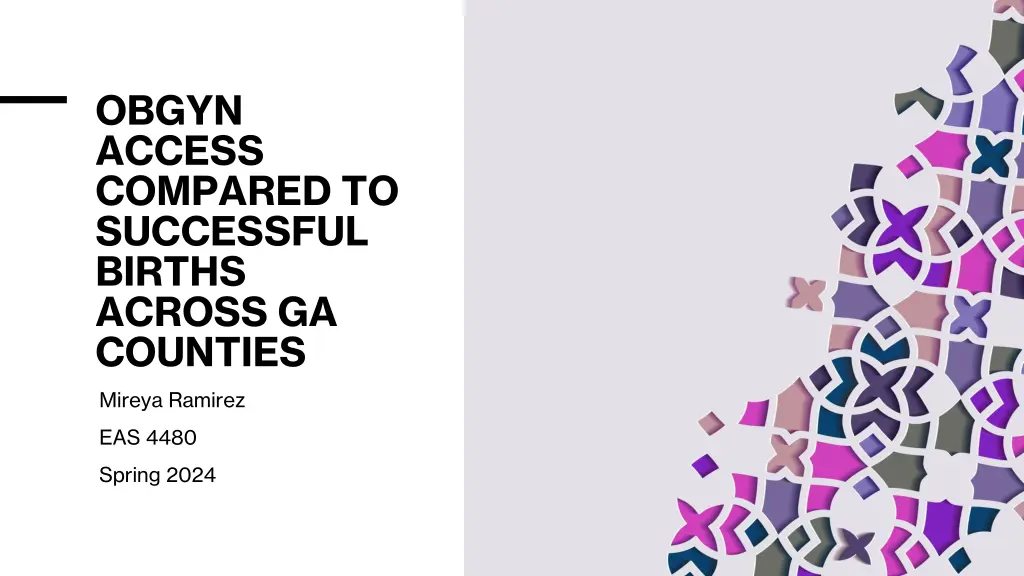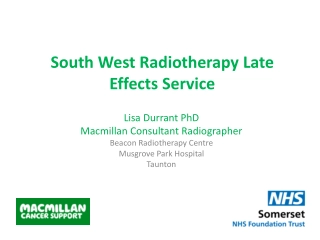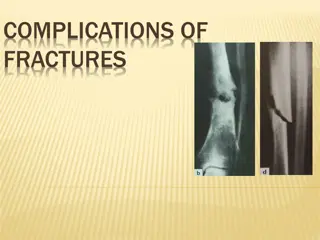
OBGYN Access Impact on Successful Births in Georgia
Explore the correlation between OBGYN access and successful births across different counties in Georgia. The research aims to understand how the availability of obstetricians affects healthy births, considering factors like practitioner numbers, deaths related to healthcare access, and various aspects of maternal and infant health. The study emphasizes the significance of OBGYN care throughout pregnancy, highlighting the potential influence on positive birth outcomes.
Download Presentation

Please find below an Image/Link to download the presentation.
The content on the website is provided AS IS for your information and personal use only. It may not be sold, licensed, or shared on other websites without obtaining consent from the author. If you encounter any issues during the download, it is possible that the publisher has removed the file from their server.
You are allowed to download the files provided on this website for personal or commercial use, subject to the condition that they are used lawfully. All files are the property of their respective owners.
The content on the website is provided AS IS for your information and personal use only. It may not be sold, licensed, or shared on other websites without obtaining consent from the author.
E N D
Presentation Transcript
OBGYN ACCESS COMPARED TO SUCCESSFUL BIRTHS ACROSS GA COUNTIES Mireya Ramirez EAS 4480 Spring 2024
Scientific Problem & Motivation - How does access to OBGYN s affect successful births (healthy) across Georgia Counties? - I hypothesize more OBGYN s would mean more successful births. - Many counties in GA have no practicing OBGYN s or in counties nearby (such as in South GA). - OBGYN s can affect change through all states of the pregnancy process, from fertility, to maternal care, to infant care.
Considerations - I am not considering county size or population because of difficulty when working with data, however the number of pregnancies recorded by county that lead to successful births should reflect the population of the county. - All data comes from the GA Department of Public Health & GEORGIA BOARD of - HEALTH CARE WORKFORCE and is largely voluntary.
What is classified as a successful birth according to data found? Successful Births: Pregnancy leading to a live and healthy baby & healthy mother - Data that quantifies unsuccessful births - Number of Live Births - Feto-Infant Mortality - Very Low Birthweight - Premature Live Births: went unused as premature births don t necessarily indicate an unhealthy birth - Unfortunately, not enough data could be found on Maternal Mortality, so that is not included in the analysis
What is Good OBGYN Access? OBGYN Practitioners Number of OBGYN s per county (for years: 1994, 1996, 1998, 2000, 2002, 2004, 2006, 2008, 2010, 2013, 2015, 2017, 2020) Deaths Related to Health Care Level & Access Women s Health Care Maternal Health Care Newborn Health Care Infant Health Care Prenatal Visits Data not included because it was missing for all counties 2008-2014
VISUALIZING THE DATA Deaths Caused by Issues that Could ve been Prevented at Different Levels of HealthCare 1994 2004 2013 2020
Univariate: Mean & Standard Deviation of OBGYN s per county across years. I chose this to understand how the number of OBGYN s increased across all of GA over the years Boxplot of OBGYNs across counties in certain years, I chose this to visualize the spread of data between counties on the number of OBGYN s Bivariate Least Squares was chosen to compare Fetus-Infant Mortality Rate & Healthy Births Against OBGYN Numbers to show a correlation between the datasets. Reduced Major Axes was used for the same comparison of the means across years because it can be assumed that there is error in both datasets as not every death is recorded and there could be physicians doing OBGYN work with quality, but reporting as one. Principal Component was chosen because the viability and success of a birth can be affected by many other things even with the best of care Bootstrap was chosen to show uncertainty Visual Analysis of Change Over Time What Analyses Were Chosen & Why? I wanted to look at if the peaks of OBGYN Number will correspond with the peaks of Healthy Births and data troughs of Fetus-Infant Mortality
Univariate Analysis - Between 1994 and 2020 the average amount of OBGYN s per county increased from 5.09 to 8.97. However Standard Deviation also increased from 19.8892 to 33.1245 - The figure shows OBGYN numbers across counties at 4 points in time
Bivariate Analysis Least - Sqaures - Healthy Births Versus OBGYN Number - According to the r value there is no relationship. - According to the p value there is not significant evidence of correlation. - Feto Infant Mortality Rate Versus OBGYN Number - According to the r value there is near a linear relationship. - According to the p value there IS significant evidence of correlation.
Bivariate Analysis Reduced Major Axis - Healthy Births Versus OBGYN Number - There is no relationship between the two datasets - Feto Infant Mortality Rate Versus OBGYN Number - There is a relatively positive relationship between the two datasets
Bivariate Analysis Principal Component - Healthy Births Versus OBGYN Number - At this point it was clear there was no relationship so principal companant regression was not done - Feto Infant Mortality Rate Versus OBGYN Number - There is a relatively positive relationship between the two datasets
Bivariate Analysis Bootstrap - Feto Infant Mortality Rate Versus OBGYN Number - The 95% interval of Regression Slope using the bootstrap method is 1.6725, 6.3984
Visual Analysis of Change Over Time - Where there is more OBGYN s there should be less Fetus-Infant Mortality. So there should be an inverse relationship. - However, there is not an inverse relationship.
Synthesizing the Results As we can see there is a correlation/relationship of OBGYNs to Successful births. However, it can be shown in the last figure that this relationship is largely positive, meaning that as there is more OBGYN s in an area the number of Successful births (As indicated by Fetus-Infant Mortality, in this case) goes down.
Contextualizing the Results - However, this is very likely not the case. - If we contextualize the data: - Although the number of OBGYN s per county has been largely increasing so likely has the population. If population is outgrowing OBGYN s at a much faster rate than that means that even though Fetus-Infant Mortality is increasing, its rate in reference to the population could be decreasing. - As we see at the end of the time figure, just show, the OBGYN Number and Fetus Infant Mortality seem to changing in relationship. This could be because of the previous statement, or perhaps reporting methods have improved - Because of data formatting issues, all data points are simply the amount per county and not rate per county. If in the future population is used as reference, it could very likely give a different result.
To Improve Before submitting the paper - To fully look into the research and understand if the results will hold true with population. I will compare FIMR & OBGYN per 100k to take into account population to see if my hypothesis about the population out-tracking OBGYN growth is correct. - Uncertainty Analysis
References - https://oasis.state.ga.us/ - Georgia. Department of Community Health (1994). Physicians by county by specialty, Georgia, 1994. Retrieved from https://dlg.galileo.usg.edu/do:dlg_ggpd_y-ga-bc910-b-ps1-bp47-b1994-belec-p-btext - Georgia. Department of Community Health (1996). Physicians by specialty by county, Georgia, 1996. Retrieved from https://dlg.usg.edu/record/dlg_ggpd_y-ga-bc910-b-ps1-bp47-b1996-belec-p-btext - Georgia. Department of Community Health (1998). Physicians by specialty by county, Georgia, 1998. Retrieved from https://dlg.usg.edu/record/dlg_ggpd_y-ga-bc910-b-ps1-bp47-b1998-belec-p-btext - Georgia. Department of Community Health (2000). Physicians by specialty by county, Georgia, 2000. Retrieved from https://dlg.usg.edu/record/dlg_ggpd_y-ga-bc910-b-ps1-bp47-b2000-belec-p-btext - Georgia. Department of Community Health (2002). Physicians by specialty by county, Georgia, 2002. Retrieved from https://dlg.usg.edu/record/dlg_ggpd_y-ga-bc910-b-ps1-bp47-b2002-belec-p-btext - Georgia. Department of Community Health (2004). Physicians by specialty by county, Georgia, 2004. Retrieved from https://dlg.usg.edu/record/dlg_ggpd_y-ga-bc910-b-ps1-bp47-b2004-belec-p-btext - Georgia. Department of Community Health (2006). Physicians by specialty by county, Georgia, 2006. Retrieved from https://dlg.usg.edu/record/dlg_ggpd_y-ga-bc910-b-ps1-bp47-b2006-belec-p-btext - Georgia. Department of Community Health (2008). Physicians by specialty by county, Georgia, 2008. Retrieved from https://dlg.usg.edu/record/dlg_ggpd_y-ga-bc910-b-ps1-bp47-b2008-belec-p-btext - Georgia. Department of Community Health (2010). Physicians by specialty by county, Georgia, 2010. Retrieved from https://dlg.galileo.usg.edu/do:dlg_ggpd_y-ga-bc910-b-ps1-bp47-b2010-belec-p-btext - Georgia. Department of Community Health (2013). Physicians by specialty by county, Georgia, 2013. Retrieved from https://dlg.galileo.usg.edu/do:dlg_ggpd_y-ga-bc910-b-ps1-bp47-b2013-belec-p-btext - Georgia. Department of Community Health (2015). Physicians by specialty by county, Georgia, 2015. Retrieved from https://dlg.galileo.usg.edu/do:dlg_ggpd_y-ga-bc910-b-ps1-bp47-b2015-belec-p-btext - Georgia. Department of Community Health (2017). Physicians by specialty by county, Georgia, 2017. Retrieved from https://dlg.galileo.usg.edu/do:dlg_ggpd_y-ga-bc910-b-ps1-bp47-b2017-belec-p-btext - Georgia. Department of Community Health (2020). Physicians by specialty by county, Georgia, 2020. Retrieved from https://dlg.galileo.usg.edu/do:dlg_ggpd_y-ga-bc910-b-ps1-bp47-b2020-belec-p-btext






















